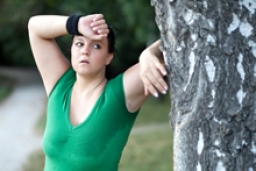Summer Safety: Preventing Heat Illness
Tuesday, July 29, 2014 - 10:00

Heat illness is a broad term that encompasses several conditions, ranging from mild heat cramps to heat stroke. Heat illness is typically caused by a combination of hot environment, strenuous exercise, inadequate adaptation to the heat, age, hydration levels and/or a poor choice of clothing. It’s always a risk in summer sports, particularly football and running.
Many factors can contribute to a person experiencing heat illness:
Acclimation/Environment: The increase in outside temperatures in spring can be problematic for many athletes if they don’t get the opportunity ease into the change. Acclimatization is the process of becoming adjusted to your environment gradually over time. If athletes in training are pushed too hard too fast, there is an increase risk that they will experience some form of heat illness.
Fitness Level/Adaptation: In order to cool the body the heart needs to pump harder to get the blood to flow out to the skin. If you are overweight or have a low fitness level, extreme heat can be an added strain on the cardiovascular system even without adding exercise into the mix. So if you decide to start training in the spring and summer, allow your body ample time to adapt to the exercise as well as the changing conditions.
Age: As we age, we do not adjust as well to sudden changes in temperature. Elderly people are also more likely to have a chronic medical condition that changes the normal body responses to heat or medication that alters their body’s ability to adapt to extreme heat. Older adults can protect themselves from heat illness by avoiding strenuous exercise during the hottest parts of the day, seeking air-conditioned environments, or taking a cool shower or bath.
Dehydration: On average, we lose about three litres of water each day through perspiration, urine and respiration. When you add a workout in on a hot day, you can quickly see how replenishing your body’s water becomes even more necessary. Even mild levels of dehydration (3-5% of body weight) can hurt athletic performance. How do you know if you are drinking enough? A good sign of hydration is the output of large volumes of clear, dilute urine.
Clothing: Loose, lightweight material allows for better air circulation and facilitates evaporation of sweat. Clothing should be lightweight, light-coloured, and loose-fitting such as cotton or a wicking fabric; avoid dark, non-breathing synthetic clothing.
 Symptoms of heat stress may include:
Symptoms of heat stress may include:
- normal or elevated body temperature
- body rash
- profuse sweating
- fast, shallow breathing and/or a fast, weak pulse
- heat cramps, nausea, vomiting, or diarrhea
- exhaustion, headache, dizziness, weakness, or fainting
Heat injury is preventable and prevention begins with understanding the causes of heat illness. Knowing the signs of heat injury will reduce the number of potential injuries and allow you to train and exercise safely during the summer.
References from the SIRC Collection:
1. Crandall C, González-Alonso J. Cardiovascular function in the heat-stressed human. Acta Physiologica. August 2010;199(4):407-423.
2. Johnson E, Kolkhorst F, Richburg A, Schmitz A, Martinez J, Armstrong L. Specific Exercise Heat Stress Protocol for a Triathlete's Return from Exertional Heat Stroke. Current Sports Medicine Reports (Lippincott Williams & Wilkins). March 2013;12(2):106-109.
3. LAROSE J, WRIGHT H, SIGAL R, BOULAY P, HARDCASTLE S, KENNY G. Do Older Females Store More Heat than Younger Females during Exercise in the Heat?. Medicine & Science In Sports & Exercise. December 2013;45(12):2265-2276.
4. Roberts W. Heat stress and athletic participation. International Sportmed Journal. June 2008;9(2):67-73.
5. Schlader Z, Stannard S, Mündel T. Exercise and heat stress: performance, fatigue and exhaustion—a hot topic. British Journal Of Sports Medicine. January 2011;45(1):3-5.
6. Tsukasa I, Naoyuki H. Effects of Heat Stress on Ocular Blood Flow during Exhaustive Exercise. Journal Of Sports Science & Medicine. March 2014;13(1):172-179.
7. YAMAZAKI F. Importance of Heat Acclimation in the Prevention of Heat Illness during Sports Activity and Work. Advances In Exercise & Sports Physiology. November 2012;18(3):53-59.